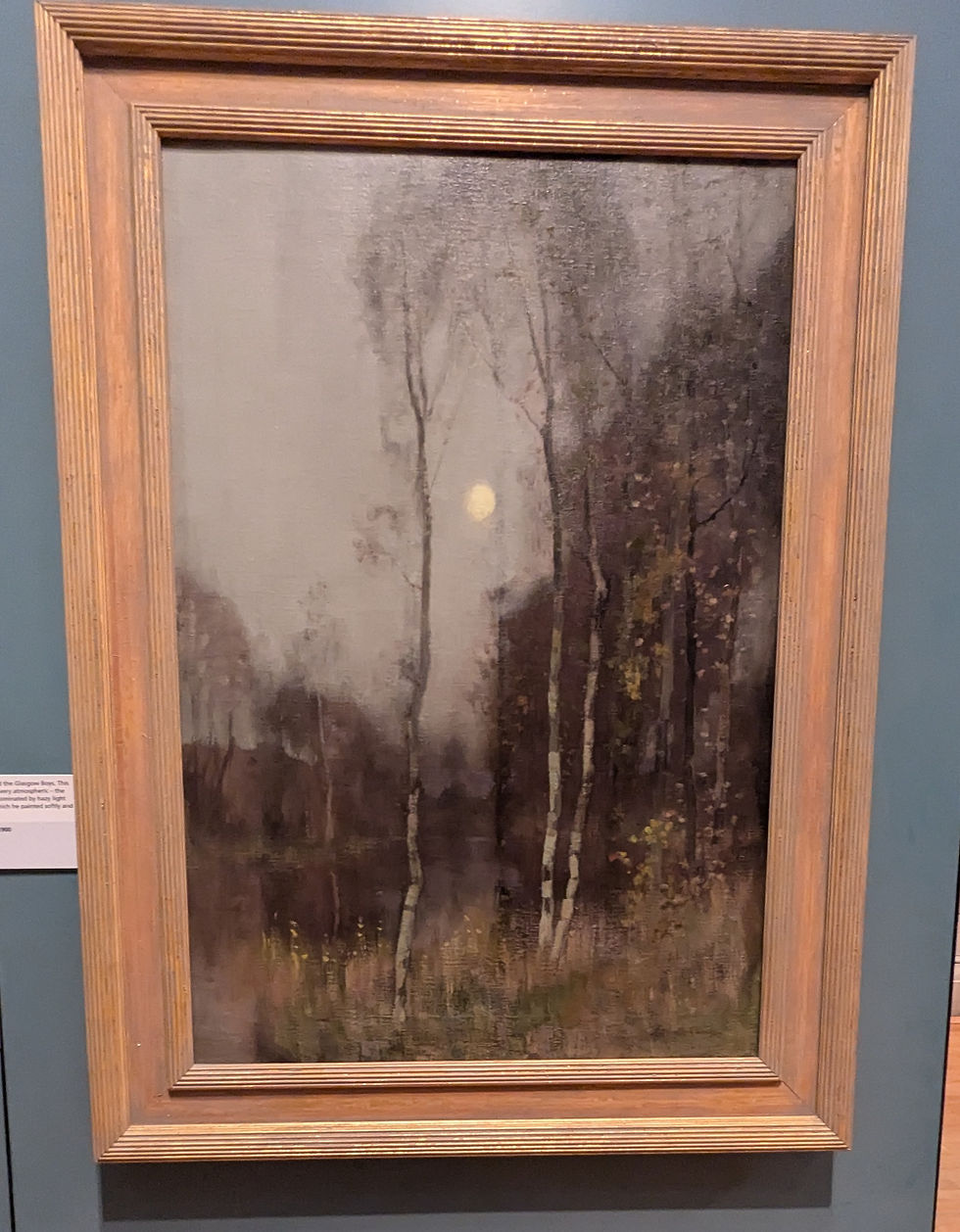Red bus, Art and Food
- chirp54
- Nov 25, 2024
- 4 min read
At our hosts' recommendation, I booked tickets on the Hop-on Hop-off Glasgow bus for two days. Our plan was to take the bus as far as the Kelvingrove Art Museum. These bus tours are pretty entertaining, and I always learn something from them, though it's quite difficult to get photos from the moving bus, As we passed the old court building we learned that in Scottish justice there are three possible verdicts in a trial: guilty, not guilty, and not proven. The bus narration said that not proven means, "We know you did it, but we can't prove it, so just don't do it again." That gives rise to the expression "getting off Scot free."
We passed the People's Palace Museum which is - wait for it - closed for refurbishment. (Of course it is!) We rode by the Nelson obelisk, and the highly decorative Carpet Factory.


In 1888, after multiple designs for his carpet factory had been rejected by the Glasgow government, James Templeton hired noted architect William Leiper to design a building so beautiful it couldn't be rejected. The building is now a mixed-use facility.
We passed the McLennan Arch, at the entrance to Glasgow Green

and The Tron Theatre (not pictured) where Stan Laurel made his show business debut. We drove by The Scotia Bar which is said to be the oldest bar in Glasgow. Some ladies in tartan tam-o-shanters were having a great time outside (I think they'd already had a wee dram.)

We drove past the Armadillo, a performing arts arena so nicknamed because of its shape (Photo courtesy Theatres Online)

and past the Riverside Museum (not pictured) before crossing back up from the riverside into town. We hopped off at the Kelvingrove Art Gallery and Museum.

The museum has a noted collection of items by Charles Rennie Mackintosh and his wife Margaret Macdonald Macintosh. Like many museums I've visited lately, it has a very eclectic collection of items, from taxidermy and skeletons right through to contemporary art, and everything in between. There were some wonderful pieces by the Mackintoshes. There was a recreation of the Ladies Luncheon Room featuring the original gesso panels by Margaret and Charles' high back chairs and stained glass panels.

The collection was lovely, but in order to really appreciate their genius, the furniture and art panels really need to be seen in the context of the buildings in which they were placed. (More about that later.) There's no denying the drama of the pieces there, though.



There were galleries of impressionists and other European artists where I saw a Van Gogh I had never seen before, Portrait of Alexander Reid.

The next gallery featured the paintings of The Glasgow Boys, a group of artists I knew nothing about. Shame on me. They were, apparently, the most significant group of artists in Britain at the end of the 19th century. The Boys, as they liked to be called, were a loose knit group of about 20 artists linked by friendship and, in most cases, a connection to Glasgow. Here were some of my favorites from that group.
Maggie Hamilton by James Guthrie, 1892-93:

Cunningham Graham by John Lavery, 1893:

Moonrise by McCauley Stevenson, about 1892-1900:

The Druids Bringing in the Mistletoe by George Henry and EA Hornel, 1890:

With such a divergence in style, it was a bit puzzling to me that they're all of the same school.
There was a gallery of paintings by the Scottish Colorists who brought a vivid French style to Scottish painting in the early 20th century.
The Pink Parasol - Bertha Case by JD Fergusson, 1908:

Girl in Blue - Reflections by FCB Cadell, about 1912:

The Old Duff by SJ Peploe, 1922:

There was a display of armor

alongside a modern take on weapons

Salvador Dali's controversial Christ of St. John of the Cross

was displayed down the hall from another figure worshipped by some.
Return to Sender by Sean Read, 1996:

One of the most striking pieces hangs in the foyer of the gallery. It's Sophie Cave's "Floating Heads."

It's an interesting place and I'd like to explore it some more but on this occasion it was time to head to trendy Ashton Lane and The Ubiquitous Chip, a restaurant that Annie at the Gannet had recommended. We were there for one thing: haggis. For the uninitiated, haggis is a traditional savory pudding made of sheep's offal minced with chopped onion, suet, spices, and oatmeal cooked in a sheep's stomach. Why, I hear you asking, would someone intentionally eat that? Well, Annie told us it was delicious and we chose to trust her. Happily for me, The Ubiquitous Chip also serves a vegan version. Haggis is served with neeps and tatties (translation: mashed turnips and mashed potatoes.) I had informed them of my dairy allergy, so my vegan haggis came with roasted potatoes and broccoli. It was actually very good. Bruce said that the real thing was good, too. Not terribly attractive, though, I'll admit.

The service was awful - it took us almost 2 hours from arrival to departure so it was late afternoon by the time we left. Bruce headed out to crawl pubs; I headed to the hop-on, hop-off bus stop, but arrived just as the last bus of the day departed from the Kelingrove stop. Grrr. I caught a bus that I hoped would take me to the city center. It dropped me at the Glasgow bus station from which I made my way into the center and caught another bus back to the flat. It was quite a long day, but a very interesting one indeed.



Comments